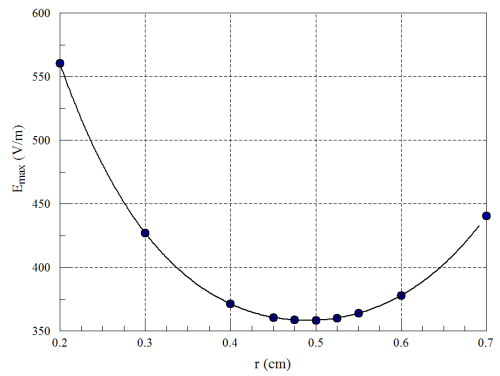To reduce the possibility of breakdowns, a common goal in high-voltage engineering is minimizing peak electric field values on electrodes for a given voltage. One example is the choice of conductor and shield radii for a coaxial cable. For a given shield radius ro, what choice of the conductor radius ri gives the lowest electric? The field on the inner conductor is high when it is a thin wire (ri ≪ ro) or when the its surface is close to the shield (ri ≲ ro). We expect a minimum at an intermediate value. The electric field on the inner conductor of a coaxial cable with applied voltage V0 is
Er(ri) =V0/[ri ln(ro/ri)].
Setting the partial derivative of Er with respect to ri equal to 0.0, we find that the minimum field occurs when
ri/ro = 1/e,
where e = 2.718. Similarly, the condition for minimum field between spherical electrodes with radii ri and ro is
ri/ro = 1/2.
In a recent electron-gun design project, the cathode was located on the spherical tip of a cylindrical electrode of radius ri with a constrained outer radius ro. For reliable gun operation, it was important to determine the peak electric field as a function of ri for the combined geometry. The application was ideal for numerical methods — an analytic solution would be require complex series expansions and would not offer an accuracy advantage. Figure 1shows the geometry for a calculation with the two-dimensional EStat code. The solution volume represented a 5.0 cm length of a coaxial transmission line with outer radius ro = 1.0 cm and applied voltage V0 = 1.0 V. For good accuracy, the element size was about 0.01 cm. I made calculations for several choices of ri. It was relatively easy to change the geometry by direct editing of the text-format EStat control script. A geometry change was effected with a global replacement of the ri values in the vectors that defined the inner conductor.

Field magnitude, solution for a terminated coaxial transmission line.
For each solution I reviewed a plot of |E| in the EStat analysis menu. In the auto-normalization mode, the code determined and displayed the maximum value of electric field magnitude in the solution volume. The color-coding in the figure shows the field distribution near the optimal value of ri. The highest field occurred near the transition from a spherical to cylindrical surface. The circles in the second figure show that maximum value of |E| in the solution volume as a function of the cathode radius. As expected, the best choice of ri was somewhat below the value for ideal spherical electrodes.

Peak electric field magnitude as a function of the cathode radius.
To find an accurate value of ri with a finite number of calculations, I made a fifth order polynomial fit to the data points (solid line in the figure) using an interactive math program. Rather than attempt to solve the resulting equation, I simply instructed the program to calculate a large number of instances over a short interval near the minimum. The best choice of inner radius was
ri/ro = 0.490.
At this value, the peak electric field for the normalized calculation was 358.2096 V/m or 3.5821(V0/ro).
For more information on EStat and HiPhi for electrostatics, please see http://www.fieldp.com/estat.html and http://www.fieldp.com/hiphi.html.
LINKS